临床检验诊断学2013详细答案年考博真题考博试卷
临床2013年真题讲解
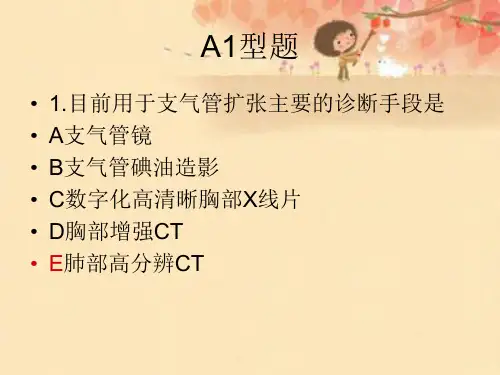
• 8.二尖瓣关闭不全的特异性特征是 • A胸骨左缘第2肋间连续性机器样杂音 • B胸骨右缘第2肋间收缩期喷射样杂音 • C心尖部全收缩期吹风样杂音 • D胸骨左缘第3肋间舒张期叹气样杂音 • E心尖部舒张中晚期隆隆样杂音
• 二尖瓣关闭不全的听诊特点是心尖区可闻 及响亮粗糙、音调较高的3/6级以上全收缩
• 16.我国急性胰腺炎的主要病因是 • A高脂饮食 • B病毒感染 • C胆道疾病 • D手术、创伤 • E药物
• 17.超声心动图上的左室壁局部于收缩期向 外突出呈矛盾运动提示:
• A:室壁瘤--A • B:限制性心肌病 • C:扩张性心肌病 • D:肥厚梗阻性心肌病 • E:风湿性心脏病
• 冠心病患者大面积心肌梗死后梗死区域出 现室壁扩张、变薄、心肌全层坏死,坏死 的心肌逐渐被纤维疤痕组织所替代,病变 区薄层的心室壁向外膨出,心脏收缩时丧 失活动能力或呈反常运动,形成室壁瘤, 常见于左心室
• E:丙氨酸氨基转移酶
• 27.男,75岁,高血压病史18年,平素血压 170/70mmHg左右,实验室检查,空腹血 糖5.6mmol/L,血肌酐180umol/L,尿蛋白 (++),该患者收缩压控制范围
• A:110以下
• B:130以下--B
• C:140以下
• D:150以下
• E:120以下
• Curling溃疡的病因为严重烧伤;Cushing溃 疡的病因为中枢神经系统严重损伤。
• 7.下列情况最易引起急性左心衰的是 • A频发室性期前收缩 • B二尖瓣腱索断裂 • C1级高血压 • D反复发作的肺栓塞 • E慢性持续性房颤
• 急性左心衰的常见病因:急性广泛性前壁 心肌梗死、心肌缺血、室间隔破裂穿孔、 高血压性心脏病、快速心律失常、输液过 快、感染性心内膜炎致瓣膜穿孔、腱索断 裂致急性二尖瓣返流。
2013年全国医学博士外语统一考试英语试题及详解【圣才出品】
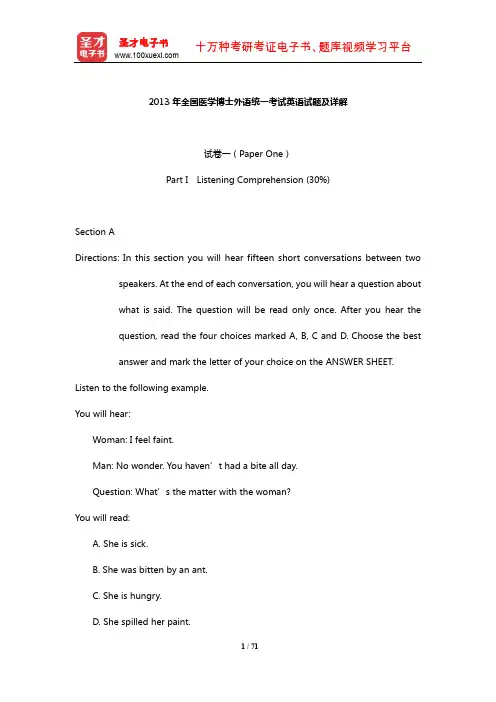
2013年全国医学博士外语统一考试英语试题及详解试卷一(Paper One)Part I Listening Comprehension (30%)Section ADirections: In this section you will hear fifteen short conversations between two speakers. At the end of each conversation, you will hear a question aboutwhat is said. The question will be read only once. After you hear thequestion, read the four choices marked A, B, C and D. Choose the bestanswer and mark the letter of your choice on the ANSWER SHEET. Listen to the following example.You will hear:Woman: I feel faint.Man: No wonder. You haven’t had a bite all day.Question: What’s the matter with the woman?You will read:A. She is sick.B. She was bitten by an ant.C. She is hungry.D. She spilled her paint.Now let’s begin with question Number 1.1. A. A cough.B. Diarrhea.C. A fever.D. Vomiting.【答案】B【解析】录音中女士说“He has a chesty cough all the time”,“His temperature is high”,“He just brings up (呕吐) bile (胆汁)”,由此可知,这个小男孩生病的症状有咳嗽,发烧和呕吐,并没有腹泻(diarrhea),故答案为B项。
重庆医科大学临床检验诊断学2013年考博真题试卷
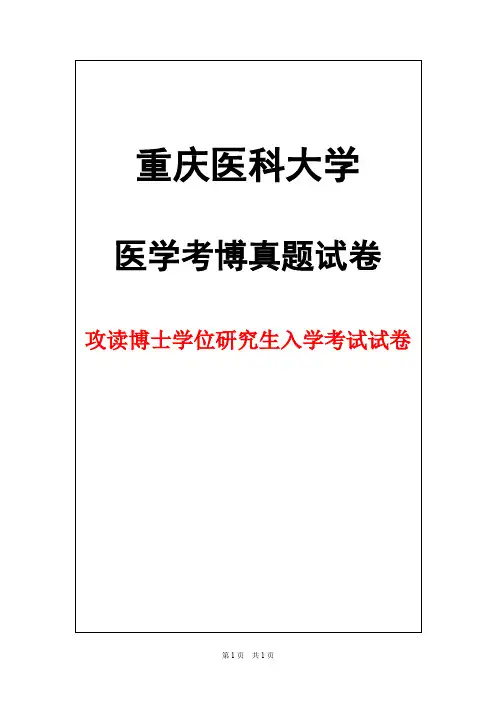
医学考博真题试卷
攻读博士学位研究生入学考试试卷
重庆医科大学
2检验诊断学
注意:所有答案一律写在答题纸上,写在试题纸上或其他地方一律不给分。
一、名词解释(全英文)
1.epigenetics
2.危急值及报告制度
3.Monoclonal protein
四、分析题
1型糖尿病、昏迷
4.Trinders reaction
5.CHIP
二、问答题:1.如何保证实验室质量及实验室间认可?
2、酶的2种活性测定方法(固定时间法,连续监测法),目前常用哪种方法?3.实时定量PCR中Taqman荧光探针的原理,与荧光染料法有何不同?
三、论述题
1.已知基因序列,但不能分离足够的蛋白质,请设计定量荧光分析方法2.黄疸测定比较表(3种黄疸)
医学博士考试01-06试题 加详解
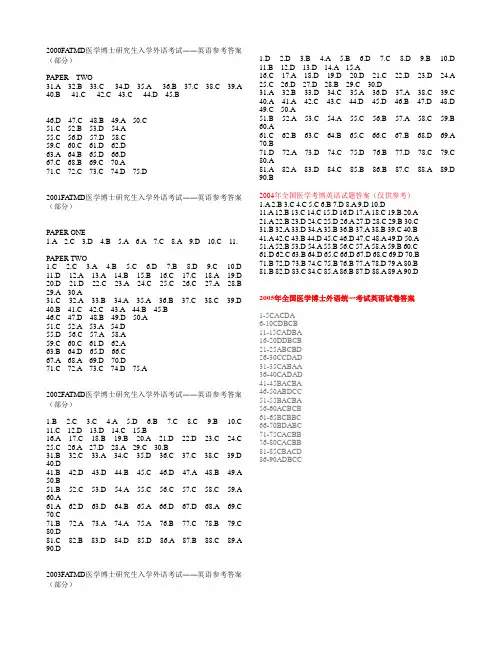
2000FA TMD医学博士研究生入学外语考试――英语参考答案(部分)PAPER TWO31.A 32.B 33.C 34.D 35.A 36.B 37.C 38.C 39.A 40.B 41.C 42.C 43.C 44.D 45.B46.D 47.C 48.B 49.A 50.C51.C 52.B 53.D 54.A55.C 56.D 57.D 58.C59.C 60.C 61.D 62.D63.A 64.B 65.D 66.D67.C 68.B 69.C 70.A71.C 72.C 73.C 74.D 75.D2001FA TMD医学博士研究生入学外语考试――英语参考答案(部分)PAPER ONE1.A2.C3.D4.B5.A6.A7.C8.A9.D 10.C 11. PAPER TWO1.C2.C3.A4.B5.C6.D7.B8.D9.C 10.D 11.D 12.A 13.A 14.B 15.B 16.C 17.C 18.A 19.D 20.D 21.D 22.C 23.A 24.C 25.C 26.C 27.A 28.B 29.A 30.A31.C 32.A 33.B 34.A 35.A 36.B 37.C 38.C 39.D 40.B 41.C 42.C 43.A 44.B 45.B46.C 47.D 48.B 49.D 50.A51.C 52.A 53.A 54.D55.D 56.C 57.A 58.A59.C 60.C 61.D 62.A63.B 64.D 65.D 66.C67.A 68.A 69.D 70.D71.C 72.A 73.C 74.D 75.A2002FA TMD医学博士研究生入学外语考试――英语参考答案(部分)1.B2.C3.C4.A5.D6.B7.C8.C9.B 10.C 11.C 12.D 13.D 14.C 15.B16.A 17.C 18.B 19.B 20.A 21.D 22.D 23.C 24.C 25.C 26.A 27.D 28.A 29.C 30.B31.B 32.C 33.A 34.C 35.D 36.C 37.C 38.C 39.D40.D41.B 42.D 43.D 44.B 45.C 46.D 47.A 48.B 49.A50.B51.B 52.C 53.D 54.A 55.C 56.C 57.C 58.C 59.A60.A61.A 62.D 63.D 64.B 65.A 66.D 67.D 68.A 69.C70.C71.B 72.A 73.A 74.A 75.A 76.B 77.C 78.B 79.C80.D81.C 82.B 83.D 84.D 85.D 86.A 87.B 88.C 89.A 90.D2003FA TMD医学博士研究生入学外语考试――英语参考答案(部分)1.D 2.D 3.B 4.A 5.B 6.D 7.C 8.D 9.B 10.D 11.B 12.D 13.D 14.A 15.A16.C 17.A 18.D 19.D 20.D 21.C 22.D 23.D 24.A 25.C 26.D 27.D 28.B 29.C 30.D31.A 32.B 33.D 34.C 35.A 36.D 37.A 38.C 39.C 40.A 41.A 42.C 43.C 44.D 45.D 46.B 47.D 48.D 49.C 50.A51.B 52.A 53.C 54.A 55.C 56.B 57.A 58.C 59.B60.A61.C 62.B 63.C 64.B 65.C 66.C 67.B 68.D 69.A70.B71.D 72.A 73.D 74.C 75.D 76.B 77.D 78.C 79.C80.A81.A 82.A 83.D 84.C 85.B 86.B 87.C 88.A 89.D 90.B2004年全国医学考博英语试题答案(仅供参考)1.A2.B3.C4.C5.C6.B7.D8.A9.D 10.D11.A 12.B 13.C 14.C 15.D 16.D 17.A 18.C 19.B 20.A21.A 22.B 23.D 24.C 25.D 26.A 27.D 28.C 29.B 30.C31.B 32.A 33.D 34.A 35.B 36.B 37.A 38.B 39.C 40.B41.A 42.C 43.B 44.D 45.C 46.D 47.C 48.A 49.D 50.A51.A 52.B 53.D 54.A 55.B 56.C 57.A 58.A 59.B 60.C61.D 62.C 63.B 64.D 65.C 66.D 67.D 68.C 69.D 70.B71.B 72.D 73.B 74.C 75.B 76.B 77.A 78.D 79.A 80.B81.B 82.D 83.C 84.C 85.A 86.B 87.D 88.A 89.A 90.D2005年全国医学博士外语统一考试英语试卷答案1-5CACDA6-10CDBCB11-15CADBA16-20DDBCB21-25ABCBD26-30CCDAD31-35CABAA36-40CADAD41-45BACBA46-50ABDCC51-55BACBA56-60ACBCB61-65BCBBC66-70BDABC71-75CACBB76-80CACBB81-85CBACD86-90ADBCC2006年全国医学博士外语统一考试英语试卷答案31-40 CDCCB BCBDA41-50 ACACA ACDDB51-60 BCACA AADBC61-70 DDDDA ACABD71-80ACCCC BCAAD81-90DBDBD DDBBC2001part III vocabulary(15%)1.we are all overwhelmed with more facts and information than we can possibly____A.feedB.maintainC.absorbD.consume2.pleasure,or joy, is vital to ____health. vital.生死攸关的, 重大的, 生命的, 生机的, 至关重要的, 所必需的A.optimistic pessimistic悲观的B.optional可选择的, 随意的C.optimal最佳的, 最理想的near optimal近似最佳D.operational3.A ____ effort is required to achieve health.mitted 承担义务的;忠于既定立场的;坚定的B.restrictedposed镇静的, 沉着的D.sophisticated诡辩的, 久经世故的4.A person’s belief ____ and colors his experience.A.contradicts vt.同...矛盾, 同...抵触contradict a statement驳斥一项声明contradict oneself自相矛盾B.shapes shape the destiny of决定...的命运C.summarizes概述, 总结, 摘要而言D.exchanges交换, 调换, 兑换, 交流, 交易.exchange experience 交流经验5.Many professors encourage students to question and ____ their idearsA.convey vt.搬运, 传达, 转让I can't convey my feelings in words.我的情感难以言表。
年全国医学博士英语统考真题及参考答案
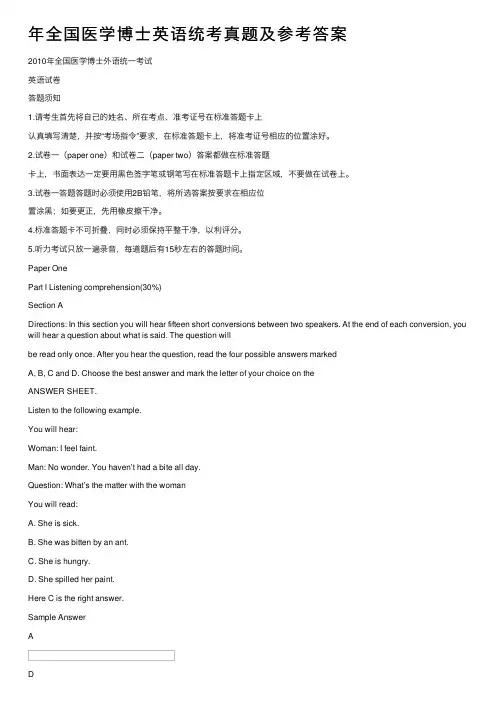
年全国医学博⼠英语统考真题及参考答案2010年全国医学博⼠外语统⼀考试英语试卷答题须知1.请考⽣⾸先将⾃⼰的姓名、所在考点、准考证号在标准答题卡上认真填写清楚,并按“考场指令”要求,在标准答题卡上,将准考证号相应的位置涂好。
2.试卷⼀(paper one)和试卷⼆(paper two)答案都做在标准答题卡上,书⾯表达⼀定要⽤⿊⾊签字笔或钢笔写在标准答题卡上指定区域,不要做在试卷上。
3.试卷⼀答题答题时必须使⽤2B铅笔,将所选答案按要求在相应位置涂⿊;如要更正,先⽤橡⽪擦⼲净。
4.标准答题卡不可折叠,同时必须保持平整⼲净,以利评分。
5.听⼒考试只放⼀遍录⾳,每道题后有15秒左右的答题时间。
Paper OnePart I Listening comprehension(30%)Section ADirections: In this section you will hear fifteen short conversions between two speakers. At the end of each conversion, you will hear a question about what is said. The question willbe read only once. After you hear the question, read the four possible answers markedA, B, C and D. Choose the best answer and mark the letter of your choice on theANSWER SHEET.Listen to the following example.You will hear:Woman: I feel faint.Man: No wonder. You haven’t had a bite all day.Question: What’s the matter with the womanYou will read:A. She is sick.B. She was bitten by an ant.C. She is hungry.D. She spilled her paint.Here C is the right answer.Sample AnswerADNow let’s begin with question Number 1.1. A. She’s looking for a gift.B. She needs a new purse.C. She’s going to give a birthday party.D. She wants to go shopping with her mom.2. A. She hears noises in her ears day and night.B. She has been overworking for a long time.C. Her right ear, hurt in an accident, is troubling her.D. Her ear rings are giving her trouble day and night.3. A. He’ll go to see Mr. White at 10:30 tomorrow.B. He’d like to make an earlier appointment.C. He’d like to cancel the appointment.D. He’d like to see another dentist.4. A. 8:00 B. 8:15 C. 8:40 D. 8:455. A. In a hotel. B. At a fast food bar.C. In the supermarket.D. In the department store.6. A. To resign right away.B.To work one more day as chairman.C.To think twice before he make the decision.D.To receive further training upon his resignation.7. A. She didn’t do anything in particular.B.She send a wounded person to the ER.C.She had to work in the ER.D.She went skiing.8. A. A customs officer. B. The man’s mother.C. A school headmaster.D. An immigration officer.9. A. It feels as if the room is going around.B.It feels like a kind of unsteadiness.C.It feels as if she is falling down.D.It feels as if she is going around.10. A. John has hidden something in the tree.B.John himself should be blamed.C.John has a dog that barks a lot.D.John is unlucky.11. A. The chemistry homework is difficult.B.The chemistry homework is fun.C.The math homework is difficult.D.The math homework is fun.12. A. His backache. B. His broken leg.C. His skin problem.D. His eye condition.13. A. Whooping cough, smallpox and measles.B.Whooping cough, chickenpox and measles.C.Whooping cough, smallpox and German measles.D.Whooping cough, chickenpox and German measles.14. A. Saturday morning. B. Saturday night.C. Saturday afternoon.D. Next weekend.15. A. He’s lost his notebook.B.His handwriting is messy.C.He’ll miss class latter this week.D.He cannot make it for his appointment.Section BDirections: In this section you will hear one conversion and two passages, after each of which, you will hear five questions. After each question, read the four possible answers marked A,B, C and D. Choose the best answer and mark the letter of your choice on theANSWER SHEET.Conversation16. A. He is having a physical checkup.B.He has just undergone an operation.C.He has just recovered from an illness.D.He will be discharged from the hospital this afternoon.17. A. He got an infection in the lungs.B.He had his gallbladder inflamed.C.He was suffering from influenza.D.He had developed a big kidney tone.18. A. A lot better. B. Terribly awful.C. Couldn’t be better.D. Okay, but a bit weak.19. A. To be confined to a wheelchair.B.To stay indoors for a complete recovery.C.To stay in bed and drink a lot of water.D.To move about and enjoy the sunshine.20. A. From 4 pm to 6 pm. B. From 5 pm to 7 pm.C. From 6 pm to 8 pm.D. From 7 pm to 9 pm.Passage One21. A. The link between weight loss and sleep deprivation.B.The link between weight gain and sleep deprivation.C.The link between weight loss and physical exercise.D.The link between weight gain and physical exercise.22. A. More than 68,000. B. More than 60,800.C. More than 60,080.D. More than 60,008.23. A. Sever-hour sleepers gained more weight over time than 5-hour ones.B.Five-hour sleepers gained more weight over time than 7-hour ones.C.Short-sleepers were 15% more likely to become obese.D.Short-sleepers consumed fewer calories than long sleepers.24. A. Overeating among the sleep-deprived.B.Little exercise among the sleep-deprived.C.Lower metabolic rate resulting from less sleep.D.Higher metabolic rate resulting from less sleep.25. A. Exercise every day. B. Take diet pills.C. Go on a diet.D. Sleep more.Passage Two26. A. She is too hard on me.B.She asks too many questions.C.She is always considerate of my feelings.D.She is the meanest mother in the neighborhood.27. A. A university instructor. B. A teaching assistant.C. A phD student.D. A psychiatrist.28. A. They usually say no.B.They usually say yes.C.They usually wait and see.D.They usually refuse to say anything.29. A. They are overconfident.B.Their brains grow too fast.C.They are psychologically dependent.D.Their brains are still immature in some areas.30. A. Be easy on your teen.B.Try to be mean to your teen.C.Say no to your teen when necessary.D.Don’t care about your teen’s feelings.Part II Vocabulary (10%)Section ADirections: In this section all the statements are incomplete, beneath each of which are four words or phrases marked A, B, C and D. Choose the word or phrase that can bestcomplete the statement and mark the letter of your choice on the ANSWERSHEET.31. A number of black youths have complained of being by the police.A. harassedB. distractedC. sentencedD. released32. He rapidly became with his own power in the team.A. irrigatedB. irradiatedC. streetlightD. torchlight33. Throughout his political career he has always been in the .A. twilightB. spotlightC. streetlightD. torchlight34. We that diet is related to most types of cancer but we don’t have definite proof.A. suspendB. superveneC. superviseD. suspect35. A patient who is dying of incurable cancer of the throat is in terrible pain, which can nolonger be satisfactorily .A. alleviatedB. abolishedC. demolishedD. diminished36. The television station is supported by from foundations and other sources.A. donationsB. pensionsC. advertisementsD. accounts37. More legislation is needed to protect the property rights of the patent.A. integrativeB. intellectualC. intelligent38. Officials are supposed to themselves to the welfare and health of the generalpublic.A. adaptB. confineC. commitD. assess39. You should stop your condition and do something about it.A. drawing onB. touching onC. leaning onD. dwelling on40. The author of the book has shown his remarkably keen into human nature.A. perspectiveB. dimensionC. insightD. reflectionSection BDirections: In this section each of the following sentences has a word or phrase underlined, beneath which are four words or phrase. Choose the word or phrase which canbest keep the meaning of the original sentence if it is substituted for theunderlined part. Then mark the letter of your choice on the ANSWER SHEET.41.The chemical was found to be detrimental to human health.A. toxicB. immuneC. sensitiveD. allergic42.It will be a devastating blow for the patient, if the clinic closes.A. permanentB. desperateC. destructiveD. sudden43.He kept telling us about his operation in the most graphic detail.A. verifiableB. explicitC. preciseD. ambiguous44.The difficult case tested the ingenuity of even the most skillful physician.A. credibilityB. commitmentC. honestyD. talent45.He left immediately on the pretext that he had to catch a train.A. claimB. clueC. excuseD. talent46.The nurse was filled with remorse of not believing her .A. anguishB. regretC. apologyD. grief47.The doctor tried to find a tactful way of telling her the truth.A. delicateB. communicativeC. skillfulD. considerate48.Whether a person likes a routine office job or not depends largely on temperament.A. dispositionB. qualificationC. temptationD. endorsement49.The doctor ruled out Friday’s surgery for the patient’s unexpected complications.A. confirmedB. facilitatedC. postponedD. cancelled50.It is not easy to remain tranquil when events suddenly change your life.A. cautiousB. motionlessC. calmD. alertPart III Cloze(10%)Directions: In this section there is a passage with ten numbered blanks. For each blank, there are four choice marked A, B, C and D listed on the right side. Choose the best answer andmark the letter of your choice on the ANSWER SHEET.Experts say about 1% of young women in the United States are almost starving themselves today. They are suffering from a sickness called anorexia.These young women have an abnormal fear of getting fat. They 51 starve themselves so they weigh at 15% less than their normal weight.The National Institute of Mental Health says one 52 ten cases of anorexia leads to serious medical problems. These patients can die from heart failure or the disease can lead young women to 53 themselves. For example, former gymnast Christy Henrich died at age 22. She weighed only61 pounds.A person with anorexia first develops joint and muscle problems. There is a lack of iron in the blood. 54 the sickness progresses, a young woman’s breathing, heartbeat, and blood pressure rates slow down. The important substance calcium is 55 from the bones, something causing bones to break. Sometimes the brain gets smaller, causing changes in 56 a person thinks and acts. Scientists say many patients have further mental and emotional problems. They have 57 opinions about themselves. They feel helpless. Their attempts to become extremely thin may 58 efforts to take control of their lives. They may become dependent on illegal drugs. Some people also feel the need to continually repeat a(n) 59 . For example, they may repeatedly wash their hands although their hands are clean.Anorexia is a serious eating 60 .If it is not treated on time, it can be fatal.51. A. specifically B. purposely C. particularly D. passionately52. A. from B. of C. at D. in53. A. kill B. starve C. abuse D. worsen54. A. When B. While C. As D. Since55. A. lost B. derived C. generated D. synthesized56. A. what B. why C. how D. which57. A. good B. high C. lower D. poor58. A. represent B. make C. present D. exert59. A. medication B. illusion C. motion D. action60. A. habit B. behavior C. disorder D. patternPart IV Reading Comprehension(30%)Direction:In this part there are six passages, each of which is followed by five questions. For each question there are four possible answers marked A, B, C and D. Choose the bestanswer and mark the letter of your choice on the ANSWER SHEET.Passage OneChildren should avoid using mobile phones for all but essential calls because of possible health effects on young brains. This is one of the expected conclusions of an official government report to be published this week. The report is expected to call for the mobile phone industry to refrain from promoting phone use by children, and to start labeling phones with data on the amount of radiation they emit.The Independent Expert Group on Mobile Phones, chaired by former government chief scientist William Stewart, has spent eight months reviewing existing scientific evidence on all aspects of the health effects of using mobile phones. Its report is believed to conclude that because we don’t fully understand the nonthermal effects of radiation on human tissue, the government should adopt a precautionary approach, particularly in relation to children.There is currently no evidence that mobile phones harm users or people living near transmitter masts. But some studies show that cell-phones operating at radiation levels within current safety limits do have some sort of biological effect on the brain.John Tattersall, a researcher on the health effects of radiation at the Defense Evaluation and Research Agency’s site at Porton Down, agrees that it might be wise to limit phone use by children. “If you have a developing nervous system, it’s known to be more susceptible to environmental insults,” he says,“So if phones did prove to be hazardous——which they haven’t yet ——it would be sensible.”In 1998, Tattersall showed that radiation levels similar to those emitted by mobile phones could alter signals from brain cells in slices of rat brain, “What we’ve found is an effect, but we don’t know if it’s hazardous,” he says.Alan Preece of the University of Bristol, who found last year that microwaves increase reaction times in test subjects, agreed that children’s exposure would be greater. “There’s a lot less tissue in the way, and the skill is thinner, so children’s heads are considerably closer,” he says.Stewart’s report is likely to recommend that the current British safety standards on energy emissions from cell-phones should be cut to the level recommended by the International Commission on Non-Ionizing Radiation Protection, which is one-fifth of the current British limit. “The extra safety factor of five is somewhat arbitrary,” says Michael Clark of th e National Radiological Protection Board. “But we accept that it’s difficult for the UK to have different standards from an international body.”61. Just because it has not been confirmed yet whether mobile phone emissions can harm humantissue, according to the government report, does not mean that .A. the government should prohibit children from using cell-phonesB. we should put down the phone for the sake of safetyC. the industry can have a right to promote phone useD. children are safe using cell-phones62. Tattersall argues that it is wise to refrain mobile phone use by children in termsof .A. their neural developmentB. their ill-designed cell-phonesC. the frequency of their irrational useD. their ignorance of its possible health effects63. On the issue in question, Preece .A. does not agree with TattersallB. tries to remove the obstacles in the wayC. asks for further investigationD. would stand by Stewart64. What is worrisome at present is that the UK .A. is going to turn deaf ears to the voice of Stesart’s planB. finds it difficult to cut the current safety standards on phone useC. maintains different standards on safety limit from the international onesD. does not even impose safety limit on the mobile phones’ energy emissions65.Which of the following can bi the best candidate for the title of the passageA . Brain Wave B. For Adults OnlyC. Catch Them YoungD. The Answer in the AirPassage TwoAdvances in cosmetic dentistry and plastic surgery have made it possible to correct facial birth defects, repair damaged teeth and tissue, and prevent or greatly delay the onset of tooth decay and gum disease. As a result, more people smile more often and more openly today than ever in the past, and we can expect more smiles in the future.Evidence of the smile’s ascent may be seen in famous paintings in museums and galleries throughout the world. The vast majority of prosperous bigwigs(要⼈),voluptuous nudes, ormiddle-class family members in formal portraits and domestic scenes appear to have their mouths firmly closed. Soldiers in battle, children at play, beggars, old people, and especially villains may have their mouths open; but their smiles are seldom attractive, and more often suggest strain or violence than joy.Smiles convey a wide range of meanings in different eras and cultures, says art historian Angus Trumble, currently curator(馆长)of Yale University’s Center for British Art, in his book A Brief History of the Smile. Compare, for instance, the varying impressions made by the shy dimples(酒窝)of Leonardo’s Mona Lisa; the rosy-cheeked, mustachioed Laughing Cavalier of Frans Hals; and the”Smiley Face”logo perfected(though not invented)in 1963 by American graphic artist Harvey .In some non-Western cultures, Trumble notes, even a warm, open smile does not necessarily indicate pleasure or agreement. It can simply be a polite mask to cover emotions considered too rude or shocking to bi openly displayed.Subtle differences in muscle movement can convey enormous differences in emotion, from the tranquility of bronze Buddhas, to the erotic bliss of couples entwined in stone on Hindu temples, to the fierce smirk(假笑)of a guardian demon at the entrance to a Chinese tomb.Trumble expects the impact of Western medicine and mass media to further increase the pressure on people to grin broadly and laugh openly in public.”Faint smiles are increasingly thought of in scientific and psychological circles as something that falls short of the true smile ,”and therefore suggest insincerity or lack of enthusiasm, he says.With tattooing, boby piercing, and permanent cosmetics already well established as fashion trends, one can imagine tomorrow’s beauty shops adding plastic surgeons and dentists to their staffs. These comer-store cosmeticians would offer style makeovers to reshape our lips, teeth, and jawlines to mimic the signature smile of one’s favorite celebrity.What can you say to that except” Have a nice day”66. Had it not been for cosmetic advances, as inferred from the passage, .A . people would not have been as happy as they are todayB. the rate of facial birth defect would not have declinedC . there would not have been many more open smilesD. we would not have seen smiling faces in public67. According to the passage, it seems that whether there is a smile or not in the portraits orpictures is decided by .A. one’s internal sense of the external worldB . one’s identity or social positionC . one’s times of existenceD . All of the above68. Trumble’s study on smiles shows that .A. an open smile can serve as a cover-upB . the famous portraits radiate varying smilesC. even the human muscles can arouse varying emotionsD. smiles can represent misinterpretations of different eras and cultures69. What Trumble expects to see is .A. the increasing tendency of broad grins and open smiles in publicB . further impact of Western medicine upon non-Western culturesC. a wider range of meanings to be conveyed by smilesD. more of sincerity and enthusiasm in public70 . At the end of the passage, the author implicates .A. a fortune to come with cosmetic advancesB . an identical smile for everybobyC . future changes in life styleD . the future of smilesPassage ThreeAdolf Hitler survived an assassination attempt in 1944 with the lamp of penicillin made by the Allies, a microbiologist in the UK claims. If the Nazi leader had died from bacterial infection of his many wounds, the Second World War might have been over a year earlier, saving millions of lives, says Milton Wainwright of the University of Sheffield, a noted historian of microbiology.In a paper to be published soon in Perspectives in Biology and Medicine, Wainwright reveals first-hand evidence that Hitler was treated with penicillin by his personal doctor, Theo Morrell, following an assassination attempt in which a bomb in a suitcase exploded next to Hitler’s desk. Hitler was badly hurt, fleeing the scene with his hair and trousers on fire, a badly bleeding arm and countless wooden splinter wounds from the oak table that probably saved his life.Wainwright found confirmation that Morrell gave Hitler antibiotics as a precaution in a recent translation of Morrell’s own diary. “I happened to be reading it for interest when the word penicillin jumped out at me,” he says. He then set about trying to establish where Morrell might have got the drug.At the time, penicillin was available only to the Allies. German and Czechoslovakian teams had tried without much success to make it, Wainwright says, but the small quantities that were available were weak and impure. “It’s g enerally accepted that it was no good,” says Wainwright.He reasons that Morrell would only have risked giving Hitler penicillin to prevent infections if he were confident that the antibiotic would cure, not kill the German premier. “My research shows that Morrell, in a very dodgy(危险的) position as Hitler’s doctor, would only have used pure stuff.” And the only reliable penicillin was that made by the Allies. So where did Morrell get itWainwright’s investigations revealed that Allied airmen carried penicillin, so the Germans may have confiscated some from prisoners of war. The other more likely source is from neutral countries such Spain, which received penicillin from Allied countries for humanitarian purposes, perhaps for treating sick children.“I have proof the Allies were sending it to these countries,” says Wainwright. “I’m saying this would have got through in diplomatic bags, reaching Hitler’s doctor and the higher echelons(阶层)of the Nazi party. So this was almost certainly pure, Allied penicillin.”“We can never be certain it saved Hitler’s life,” says Wainwright. But he notes that one of Hitler’s henchmen(死党),Reinhard Heydrich, died from blood poisoning after surviving acar-bomb assassination attempt. “Hair from his seat went into his wounds and gave him septicemia,” says Wainwright. Morrell may have been anxious to ensure that Hitler avoided the same fate.71. According to Wainwright, Adolf Hitler .A. might have used biological weapons in the warB. could not have committed suicide as confirmedC. could have died of bacterial infectionD. might have survived a bacterial plague72. Following his assassination in 1944, Adolf Hitler .A. began to exercise precautions against his personal attacksB. was anxious to have penicillin developed in his countryC. received an jinjection of penicillin for blood poisoningD. was suspected of being likely to get infected73. As Wainwright reasons, H itler’s personal doctor .A. cannot have dared to prescribe German-made penicillin to himB. need not have used pure antibiotic for his suspect infectionC. would have had every reason to assassinate himD. must have tried to produce penicillin74. Wainwright implies that the Third Reich .A. met the fate of collapse as expectedB. butchered millions of lives on the earthC. was severely struck by bacterial plaguesD. did have channels to obtain pure penicillin75.Which of the following can be the best title for the passageA.How Hitler Manage to Survive Assassination AttemptsB.Morrell Loyal to His German PrimierC.Hitler Saved by Allied DrugsD.Penicillin Abused in GermanPassage FourGet ready for a new kind of machine at your local gym: one that doesn’t involve huffing and puffing as you burn off calories. Instead, all you have to do is stand still for 30 seconds while the machine measures your body fat. It could then tell you exactly where you could do with losing a few pounds and even advise you on exercises for your problem areas. If the body fat scanner turns out to be accurate enough, its makers hope it could one day help doctors spot disease.The scanner works by simultaneously building up an accurate 3D image of the body, while measuring the body’s effect on an electromagnetic field. Combining the two measurements allows the researchers to work out the distribution of fat and water within. Neither method is new on itsown, says Henri Tapp, at the Institute of Food Research in Norwich in the UK. “The smart thing is that we’ve put them in one machine.”And it’s not just for gym users. The body fat scanner could be used to study fat deposition as children develop, while patients recover from injury, or during pregnancy. And since it uses radio waves rather than X-rays, Tapp’s device is safe to use repeatedly.Body shape is known to be a risk indicator for heart disease and diabetes. So accurately quantifying fat distribution could help doctors suggest preventive measures to patients before problems arise. At the moment, doctors estimate fat content from knowing body volume and water content. To a good approximation, says Tapp, anything that isn’t fat is water. The amount of water in the body is often measured by giving the subject a drink of water that contains a radioactive tracer. The level of tracer in the patient's urine after three hours reveals the total water volume.To find out a body’s volume, subjects are weighed while totally submerged in water, and this is subtracted from their normal weight to give the weight of water displaced, and hence the subject’s volume. But it is scarcely practical for seriously ill people.There are other ways to directly measure body fat, such as passing a minuscule current between the wrists and feet. The overall fat content can then be estimated from the body’s resistance. But this method doesn’t take body shape into account ——so a subject with particularly skinny legs might register a higher fat content than the true value. That’s because skinny legs—with a lower cross-sectional area——will present higher resistance to current. So the machine thinks the water content of the body is lower——rating the subject as fatter. Also, the system can only give an overall measurement of fat.Tapp’s method uses similar calculations, but is more sophisticated because it tells you where you are piling on the pounds.76. The new machine is designed .A. to picture the body’s hidden fatB. to identify those at risk for obesityC. to help clinically treat specific casesD. to measure accurately risky obesity-related effects77. The beauty of the device, according to Tapp, is that .A. it performs a dual functionB. it is of great accuracy in measurementC. it has significant implications in clinical practiceD. it contributes to the evolution of human anatomy78.Which of the following, according to the passage, does the machine have the potential tospareA. A minuscule current.B. A radioactive tracer.C. A water tank.D. All of the above.79.In comparison with the techniques mentioned in the passage, the body fat scanner .A. quickens the pace of the patient’s rehabilitationB. is highly appreciated for its safetyC. features its measuring precisionD. is easy to operate in the clinic80.For scanning, all the subject has to do is .A. take up a form of workout in the gymB. turn round the body fat scannerC. lie on the electromagnetic fieldD. sand in the systemPassage FiveThere is currently abroad a new wave of appreciation for breadth of knowledge. Curricula at universalities and colleges and programs in federal agencies extol(赞扬) the virtues of a broad education. For scientists who work in specialized jobs, it is a pleasure to escape in our spare time to read broadly in fields distant from our own. Some of us have made interdisciplinary study our occupation, which is no surprise, because much of the intellectual action in our society today lies at the interfaces between traditional disciplines. Environmental science is a good example, because it frequently requires us to be conversant in several different sciences and even some unscientific fields.Experiencing this breadth of knowledge is stimulating, but so is delving deeply into a subject. Both are wonderful experiences that are complementary practical and aesthetic(美学的)ways. They are like viewing the marvelous sculpture of knowledge in two different ways. Look at the sculpture from one perspective and you see the piece in its entirety, how its components connect to give it form, balance, and symmetry. From another viewpoint you see its detail, depth, and mass. There is no need to choose between these two perspectives in art. To do so would subtract from the totality of the figure.So it is with science. Sometimes we gaze through a subject and are reluctant to stop for too much detail. As chemists, we are fascinated by computer sciences or molecular genetics, but not enough to become an expert. Or we may be interested in an analytical technique but not enough to stay at its cutting edge. At other times, we become immersed in the detail of a subject and see its beauty in an entirely different way than when we browse. It is as if we penetrate the surface of the sculpture and pass through the crystal structure to the molecular level where the code for the entire structure is revealed. Unfortunately, in our zeal for breadth or depth, we often feel that it is necessary to diminish the value of the other. Specialists are sometimes ridiculed with names such as “nerd”or “technocrats”, generalists are often criticized for being too “soft” or knowing too little about any one thing. Both are ludicrous(可笑的) accusations that deny a part of the reality of environmental science. Let us not be divided by our passion for depth or breadth. The beauty that awaits us on either route is too precious to stifle, too wonderful to diminish by bickering(争吵).81. From a broad education to interdisciplinary study, we can see .A. the integration of theory with practiceB. the enthusiasm for breadth of knowledgeC. the rapid division of traditional disciplinesD. the confrontation between specialists and generalists82. The commentator would say that the totality of the sculpture of knowledge .A. is mainly composed of two elementsB. presents two different points of viewC. cannot be perceived from one perspective。
2013医学考博试题 4
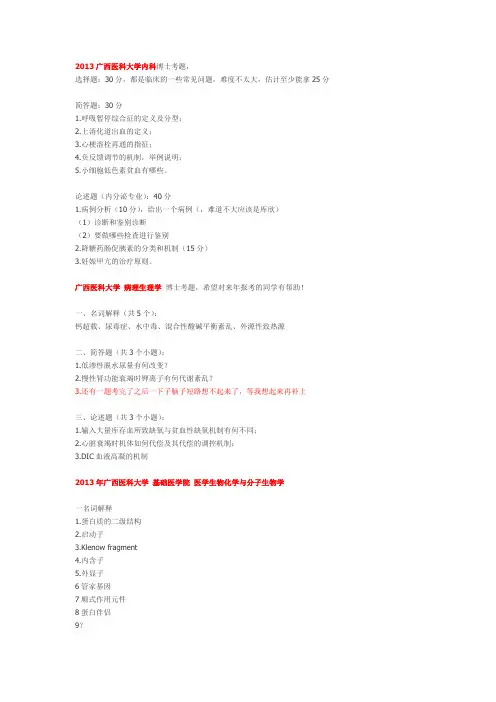
2013广西医科大学内科博士考题,选择题:30分,都是临床的一些常见问题,难度不太大,估计至少能拿25分简答题:30分1.呼吸暂停综合征的定义及分型;2.上消化道出血的定义;3.心梗溶栓再通的指征;4.负反馈调节的机制,举例说明;5.小细胞低色素贫血有哪些。
论述题(内分泌专业):40分1.病例分析(10分),给出一个病例(,难道不大应该是库欣)(1)诊断和鉴别诊断(2)要做哪些检查进行鉴别2.降糖药肠促胰素的分类和机制(15分)3.妊娠甲亢的治疗原则。
广西医科大学病理生理学博士考题,希望对来年报考的同学有帮助!一、名词解释(共5个):钙超载、尿毒症、水中毒、混合性酸碱平衡紊乱、外源性致热源二、简答题(共3个小题):1.低渗性脱水尿量有何改变?2.慢性肾功能衰竭时钾离子有何代谢紊乱?3.还有一题考完了之后一下子脑子短路想不起来了,等我想起来再补上三、论述题(共3个小题):1.输入大量库存血所致缺氧与贫血性缺氧机制有何不同;2.心脏衰竭时机体如何代偿及其代偿的调控机制;3.DIC血液高凝的机制2013年广西医科大学基础医学院医学生物化学与分子生物学一名词解释1.蛋白质的二级结构2.启动子3.Klenow fragment4.内含子5.外显子6管家基因7顺式作用元件8蛋白伴侣9?10?二简答1真核生物RNA聚合酶的种类和功能?2大肠杆菌表达系统的条件3癌基因激活的方式?4简述酶的温度调节。
三讨论1蛋白质分离纯化的种类和原理2关于三羧酸循环和尿素循环的关联性?为什么说尿素循环的氮原子都直接或间接来源于体内的氨基酸?2013年广西医科大学病理学试题一、名词解释10 *3分:化生,肿瘤的异质性,围管浸润,炎性假瘤,机化,动脉瘤,肾病综合征,早期胃癌,R eed-Sternberg cell,infarction二、简答题4*5分1、一期愈合、二期愈合的主要区别?如何获得一期愈合?2、食管癌浸润性生长可引起哪些后果?3、炎症时血管通透性升高的发生机制。
2013年临床医学检验技术(师)真题207-2相关专业知识
2013年临床医学检验技术(师)考试真题专业代码:207试卷207-2相关专业知识回忆版本,提供的答案仅供参考,尤其是打问号的,非常不确定。
1.尿胆原检查:餐后尿2.C标记呼气试验:幽门螺杆菌3.本周蛋白凝溶温度:56,1004.革兰染色不同是因为:细胞壁5.一般实验室属于生物安全水平2级?6.H-O变异:鞭毛7.排卵期阴道脱落细胞:角前为主,角化细胞增多(错)8.细粒棘球绦虫感染方式:口?接触?9.间接免疫荧光测:ANA10.HCT增高:大面积烧伤11.疟疾传染源:配子体12.活化生物素不标记:氨基(错)13.A亚型:A1、A2、其他(A3、Ax、Am)14.尿渗透压:浓缩稀释功能15.NADH的摩尔消光系数:6.2216.肾盂肾炎:脓尿17.脾不大:再障18.Ab纯化?19.不影响离子选择电极:20单位肝素?20.ALT高度上升:急性病毒性肝炎21.中性粒细胞下降:真红?22.分泌Ⅱ型干扰素:T细胞23.RIA与IRMA区别?24.根据红细胞形态,血尿分为:3类(均一、非均一、混合性)25.高钾血症:肾上腺皮质亢进(错)26.分泌TSH的是:垂体27.FⅢ:外源性凝血途径28.不属于染色体异常:随体(错)29.尿PH值升高:呕吐30.CML的NAP活性下降31.白喉:吕氏培养基32.尿蛋白选择指数:转铁蛋白/IgG33.骨髓小粒的观察:低倍镜34.NK细胞表面标志:CD56+CD16+35.不是原核细胞的是:汉塞巴通体(错)36.重症肌无力:抗乙酰胆碱受体抗体37.霍乱弧菌:TCBS38.淋病奈瑟菌:含有抗生素的巧克力平板39.前向散射光:表面属性40.侧向散射光:内部属性41.转运内源性甘油三酯:VLDL42.转运外源性甘油三酯:CM。
2013北中医神解考博真题
2013北中医神解考博真题
一、名解
1、纹状体
2、灰质
3、神经节
4、硬膜外隙
5、连合纤维
6、灰交通支
7、大脑动脉环
8、内脏神经
9、白质前连合10、蛛网膜颗粒
二、填空
1、内囊是位于()、()、()之间的白质区。
2、锥体系分为()、()。
3、左侧舌下神经损伤时伸舌偏向()。
4、瞳孔开大肌节前神经元位于(),节后神经元位于()。
5、供应大脑前2/3的动脉为(),供应大脑后1/3的动脉为()。
三、选择(单选10题,共10分,多选10题,共20分)
四、问答
1、用箭头表示瞳孔对光反射通路。
2、支配小肠的运动神经来源和咯经。
3脑脊液来源于何处,其循环路径如何。
4、针刺人中穴产生的痛觉传导的通路。
5、迷走神经各种纤维成分的性质、来源、主要分布及作用。
2013考博协和真题
2013协和考博病理学题目回忆完整版一、名解(顺序记不住,5分/题)Borderline tumor Goodpasture Syndrome 桥本氏甲状腺炎(英文忘了)卵巢Krukenburger瘤P-J综合征(英文忘了)肺原发综合征绒毛心(英文忘了)慢性肉芽肿性炎(英文忘了)二、选择(30个,1分/题)三、问答(10分/题)1、CIN 组织学分类标准2、Barrett食管定义、形态学变化、有何临床意义3、肺结核病理特点和临床表现4、AML的病理学特点和诊断标准四、论述(20分/题)1、(1)1)全身脏器急性粟粒性结核、结核性脑膜炎2) 诊断依据是什么?(2)上述病变是由哪种病变转变而来的?2、(1)糖尿病(1型?)、慢性肾小球肾炎、糖尿病微循环病变期、糖尿病神经末梢病变期、视神经萎缩?(2)至少列举4种不同器官的病理改变2013年协和医院普外科考博真题外总75分一,单选题40*1.5二,判断题10*1.5基本外科三,单选题30*1.5四,判断题15*1五,简答题3*5肠梗阻的分类结节性甲状腺肿手术指征胰岛细胞瘤定性定位诊断2013年协和医学院外科总论一、选择(选项记不清,不再罗列,见教材即是)1.腰麻术中并发症;(麻醉共有3-4道题,具体见教材)2.哪项不是全身炎症反应综合征的指标?(见外科学教材4项指标)3.人体每日需要基本的能量是(25kcal)4.物理灭菌法:5.应激性溃疡6.代谢性酸碱中毒7.每日所需蛋白质(1g)8.哪项错误?(颅内压增高病人禁用吗啡)9.手术适应症:(心梗病人6个月后才可以手术)10.哪项错误:(”高血压和指端手术,使用去甲“,错,不能用去甲,会导致肢体坏死)11.胃瘫哪项错误:(选项”引流物中含有胆汁“为错误)二、判断只记得有两道物理灭菌法和呼碱的题目,不过知识点和前面选择大概是重复的。
上海交通大学病理学2013年考博真题考博试卷
10.血吸虫干线性肝硬化,镜下门管区可见大量()周围()增生。 三、简答题 1.简述干细胞的概念,主要类型及其在再生修复中的主要作用。 2.简述急性炎症局部的基本改变及其发生的主要机制 3.简述肺气肿的原因、病变特点及其引起肺源性心脏病的主要机制 4.简述肾病综合征的主要临床表现及其内在联系,列出通常引起肾病综合征的肾病。 四、论述题 1.论述适应主要类型的概念、分类和临床意义。 2.论述肿瘤血管新生及其发生机制和对肿瘤生长的影响,如何通过抗血管生成,抑制肿瘤 生长或靶向治疗。 3.论述心肌梗死的概念、原因、类型、后期的病例特点,列举合并症 4.论述乙型病毒肝炎、门脉性肝硬化、肝细胞性肝癌的病变特点,这三种疾病的发生发展 机制 5.男性患者,21 岁,发热盗汗、咳嗽、咳痰一年余。影像学检查示 5CM 的结节状病灶, 边缘模糊不清,中央有空洞形成。两肺、肝脾肾散在小结节,痰菌结核阳性:请讨论 1、该患者的病理性诊断 2、两肺、肝脾肾散在小结节的病变特点 3、病变的发生发展过程。
攻 读 博 士 学 位 研 究 生 入 学 考 试 试 卷
医学考博真题试卷
第1页 共1页
上海交通大学
2013 年攻读博士学位研究生入学考试试题
考试科目:病理学 注意:所有答案一律写在答题纸上,写在试题纸上或其他地方一律不给分。
一、名词解释(12x2.5) 1、pathological calcification(英文) 2、肺褐色硬化 3、感染性肉芽肿 4、SLE 5、种植性转移 6、infective endocarditis 7、Barrett 食管 8、Hodgkins lypmhoma 9、粉刺癌 10、非胰岛性依赖性糖尿病 11、Alzheimer disease 12、骨肉瘤 二、填空题(0.5x20) 1.人体病理学常用的病理学诊断方法包括活检()() 2.常见于肝细胞的变性包括水变性()() 3.DIC 的病理特点是()血管内形成的() 4.Burkitt 淋巴瘤是淋巴滤泡生发中心来源的()肿瘤,发病与()感染有关 5.慢性子宫颈炎的临床病理类型包括宫颈糜烂、() () 6.毒性甲状腺肿镜下病理特点是:1 淋巴滤泡增生呈高柱状 2 滤泡内胶质() 3 间质血 管充血,()增生 7.神经胶质瘤中神经上皮细胞肿瘤主要包括()()室管膜瘤、髓母细胞瘤。 8.急性细菌性痢疾的病变特点为发生于()的()炎 9.阿米巴病的肠道肉眼病变特点为形成(),病变部位镜下可找到阿米巴()
- 1、下载文档前请自行甄别文档内容的完整性,平台不提供额外的编辑、内容补充、找答案等附加服务。
- 2、"仅部分预览"的文档,不可在线预览部分如存在完整性等问题,可反馈申请退款(可完整预览的文档不适用该条件!)。
- 3、如文档侵犯您的权益,请联系客服反馈,我们会尽快为您处理(人工客服工作时间:9:00-18:30)。
三、论述题 1.已知基因序列,但不能分离足够的蛋白质,请设计定量荧光分析方法
2.黄疸测定比较表(3 种黄疸)
一、 分析题: 1 型糖尿病、昏迷
1 型糖尿病伴昏迷患者病因多是由于中断胰岛素或胰岛素用量不足。 高糖摄入和输入如大量摄入含糖饮料、高糖食物,诊断不明时或漏诊时静脉输入大量葡萄糖 液,完全性静脉高营养,以及使用含糖溶液进行血液透析或腹膜透析等情况。尤其在某些内分泌疾病 合并糖代谢障碍的病人,如甲状腺功能亢进症、肢端肥大症、皮质醇增多症、嗜铬细胞瘤者等更易诱 发。 应激和感染如脑血管意外、急性心肌梗死、急性胰腺炎、消化道出血、外伤、手术、中暑或 低温等应激状态。感染,尤其是上呼吸道感染、泌尿系感染等最常诱发。 妊娠:尤其在妊娠后半阶段,由于胰岛素的需求显著增加,可能诱发酮症,甚至酮症酸中毒。 其他:某些药物如糖皮质激素的应用,某些疾病如库欣病、肢端肥大症、胰升糖素瘤等。
1、酶的 2 种活性测定方法(固定时间法,连续监测法),目前常用哪种方法? 1)定时法: 通过测定酶反应开始后某一时间段内(t1 到 t2)产物或底物浓度的总变化量来求取酶反应初速度
的方法,称为两点法,其中 t1 往往取反应开始的时间。在酶反应一定时间后,往往通过加入强酸、 强碱、蛋白沉淀剂等,使反应完全停止,所以也叫中止反应法。
2)连续监测法:
又称为动力学法或速率法、连续反应法。在酶反应过程中,用仪器监测某一反应产物或底物浓度 随时间的变化所发生的改变,通过计算求出酶反应初速度。
连续监测法的优点是连续观测反应进程,可以明确找到反应的线性期,结果准确可靠,标本和试 剂用量少,可在短时间内完成测定。随着自动生化仪的普及,连续监测法已经逐步取代定时法,成为 目前最常用的方法。 3.实时定量 PCR 中 Taqman 荧光探针的原理,与荧光染料法有何不同?
二.问答题: 1.如何保证实验室质量及实验室间认可?
1)明确检测依据 接受某项检测任务,首先要明确检测依据的技术标准和技术规范,熟悉和正确掌握它的技术要求和检 测条件。
2)样品的抽取
明确抽样、封样、记录、取送方。
3)样品的管理和试样的制备
为了保证样品的完好,不污染、不损坏、不变质,符合检测技术要求,应编制样品的交接、保管、使 用、处置的质量控制措施。
7)计算和数据处理
依据检验规范的有关规定,对检测数值进行正确的计算和数据处理,并经过校对验证,以确保结果正 确无误。
8)检验报告的编制和审定
检验报告的内容应完整,填写应规范、正确、清晰、判定准确,并严格执行校核、审批程序。
只有各个实验室都遵循了相应的原则以及操作步骤,保证了每个标本检验结果的准确性,在保证自己 实验室检测结果准确性的基础上,才有可能保证实验室间结果的相互认可与肯定。
攻 读 博 士 学 位 研 究 生 入 学 考 试 试 卷
医学考博真题试卷
一.名词解释(全英文)
重庆医科大学_临床检验诊断学 2013 年
1.epigenetics:表观遗传学是研究基因的核苷酸序列不发生改变的情况下,基因表达的可遗传的变化 的一门遗传学分支学科。表观遗传的现象很多,已知的有 DNA 甲基化(DNA methylation),基因组 印记(genomic imprinting),母体效应(maternal effects),基因沉默(gene silencing),核仁显性,休 眠转座子激活和 RNA 编辑(RNA editing)等。
2.危急值及报告制度(Critical Values)是指某项或某类检验异常结果,而当这种检验异常结果出现时, 表明患者可能正处于有生命危险的边缘状态,临床医生需要及时得到检验信息,迅速给予患者有效的 干预措施或治疗,就可能挽救患者生命,否则就有可能出现严重后果,失去最佳抢救机会。
检查出的结果为“危急值”,应及时复核一次,同时电话报告临床科室,如两次复查结果相同, 且确认仪器设备正常,标本采集、运送无误,方可将报告送到临床科室。临床科室仅医务人员能接有 关“危急值”报告的电话,并按要求复述一遍结果后,认真记录报告时间、检查结果、报告者。医师 接获“危急值”报告后,应根据该患者的病情,结合“危急值”的报告结果,对该患者的病情做进一 步了解,对“危急值”报告进行分析和评估。
4)外部供应的物品
对检测工作需用的从外部购进的材料、药品、试剂、器件等物品,应有明确的质量要求和进行验收的 质量控制程序。
5)环境条件
应有满足符合技术要求的工作环境,并有必要的监控环境技术参数的技术措施。
6)检测操作
检验人员要依据技术标准和检验规范规定的方法,正确、规范的进行检测操作,及时准确的记录和采 集监测数据。
4.Trinders reaction:Trinder 反应,又称“偶联终点比色法”,其原理为被测物质通过酶作用产生的过 氧化氢(H2O2)在 4—氨基替比林(4-AAP)、过氧化物酶(POD)的存在下,可生成红色醌亚胺 化合物。临床生化许多检测项目都应用了 Trinder 反应,如葡萄糖(GLU)、甘油三脂(TG)、胆固醇 (CHOL)、尿酸(UA)、高密度脂蛋白(HDL)、低密度脂蛋白(LDL)。
5.CHIP:染色质免疫沉淀(英语:Chromatin Immunoprecipitation, ChIP)被用来研究细胞内 DNA 与 蛋白质相互作用,具体来说就是确定特定蛋白(如转录因子)是否结合特定基因组区域(如启动子或 其它 DNA 结合位点)——可能定义顺反组。ChIP 还被用来确定基因组上与组蛋白修饰相关的特定位 点(即组蛋白修饰酶的靶标)。
